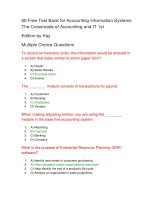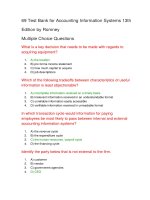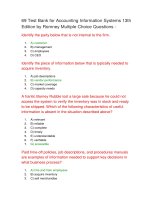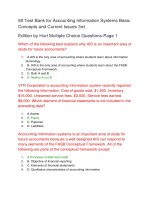97 test bank for accounting information systems 7th edition
Bạn đang xem bản rút gọn của tài liệu. Xem và tải ngay bản đầy đủ của tài liệu tại đây (100.32 KB, 27 trang )
97 Test Bank for Accounting Information Systems 7th
Edition
True-False Questions
A backbone system is completely finished, tested, and ready for
implementation.
1.
True
2.
False
Under SOX legislation public accounting firms are no longer
allowed to provide consulting services to audit clients.
1.
True
2.
False
Legacy systems were eliminated in the effort to make systems
Y2K compliant.
1.
True
2.
False
Systems development represents 80 to 90 percent of the total
cost of a computer system.
1.
True
2.
False
A balance sheet prepared in conformity with GAAP is an
example of discretionary reporting.
1.
True
2.
False
The single largest user of computer services is the personnel
function.
1.
True
2.
False
Information lacking reliability may still have value.
1.
True
2.
False
In a flat-file system, files are easily shared by users.
1.
True
2.
False
Increased control is one of the key advantages of distributed
data processing.
1.
True
2.
False
Information Technology (IT) audits can be performed by both
internal and external auditors.
1.
True
2.
False
Under SOX legislation public accounting firms are no longer
allowed to provide consulting services to their clients.
1.
True
2.
False
Transaction processing systems convert non-financial
transactions into financial transactions.
1.
True
2.
False
Most of the inputs to the General Ledger System come from the
Financial Reporting System.
1.
True
2.
False
Retrieval is the task of permanently removing obsolete or
redundant records from the database.
1.
True
2.
False
When preparing discretionary reports, organizations can
choose what information to report and how to present it.
1.
True
2.
False
The internal auditor represents the interests of third-party
outsiders.
1.
True
2.
False
The Management Reporting System provides the internal
financial information needed to manage a business.
1.
True
2.
False
Information is a business resource.
1.
True
2.
False
An information system is an example of a natural system.
1.
True
2.
False
The database administrator is responsible for the security and
integrity of the database.
1.
True
2.
False
The flat-file approach is most often associated with so-called
legacy systems.
1.
True
2.
False
One of the greatest disadvantages of database systems is that
all data is always available to all users.
1.
True
2.
False
Multiple Choice Questions
Which level of management is responsible for short-term
planning and coordination of activities necessary to accomplish
organizational objectives?
1.
a.operations management
2.
b.middle management
3.
c.top management
4.
d.line management
The author distinguishes between the Accounting Information
System and the management Information System based on
1.
a.whether the transactions are financial or nonfinancial
2.
b.whether discretionary or nondiscretionary reports are prepared
3.
c.the end users of the reports
4.
d.the organizational structure of the business
Which subsystem is not part of the Accounting Information
System?
1.
a.Transaction Processing System
2.
b.Expert System
3.
c.General Ledger/Financial Reporting System
4.
d.Management Reporting System
Which level of management is responsible for controlling dayto-day operations?
1.
a.top management
2.
b.middle management
3.
c.operations management
4.
d.executive management
In a database, a complete set of attributes for a single
occurrence of an entity class is called
1.
a.a key
2.
b.a file
3.
c.a record
4.
d.a character
The Transaction Processing System includes all of the
following cycles except
1.
a.the revenue cycle
2.
b.the administrative cycle
3.
c.the expenditure cycle
4.
d.the conversion cycle
Market research and advertising are part of which business
function?
1.
a.materials management
2.
b.finance
3.
c.marketing
4.
d.production
Useful information must possess all of the following
characteristics except
1.
a.relevance
2.
b.precision
3.
c.accuracy
4.
d.completeness
The ability to achieve the goals of a system depends upon the
effective functioning and harmonious interaction between its
subsystems. This is called
1.
a.system decomposition
2.
b.system redundancy
3.
c.backup system
4.
d.subsystem interdependency
Disadvantages of distributed data processing include all of the
following except
1.
a.mismanagement of organization-wide resources
2.
b.hardware and software incompatibility
3.
c.cost reductions
4.
d.difficulty in hiring qualified IT professionals
The purpose of the Transaction Processing System includes all
of the following except
1.
a.converting economic events into financial transactions
2.
b.recording financial transactions in the accounting records
3.
c.distributing essential information to operations personnel to support their daily
operations
4.
d.measuring and reporting the status of financial resources and the changes in those
resources
The objectives of all information systems include all of the
following except
1.
a.support for the stewardship function of management
2.
b.evaluating transaction data
3.
c.support for the day-to-day operations of the firm
4.
d.support for management decision making
Which activity is not part of the finance function?
1.
a.cash receipts
2.
b.portfolio management
3.
c.credit
4.
d.general ledger
Attestation services are performed by
1.
a.external auditors
2.
b.internal accountants
3.
c.internal auditors
4.
d.third-party accountants
Advantages of a database system include all of the following
except
1.
a.elimination of data redundancy
2.
b.open access to all data by all users
3.
c.single update for changes in data
4.
d.confidence that all data is current
Which of the following is not a business resource?
1.
a.raw material
2.
b.labor
3.
c.information
4.
d.all are business resources
When designing the data collection activity, which type of data
should be avoided?
1.
a.data that is relevant
2.
b.data that is efficient
3.
c.data that is redundant
4.
d.data that is accurate
ERP packages include all of the following modules except
1.
a.human resources
2.
b.general ledger
3.
c.inventory management
4.
d.they include all of the above
In the distributed data processing approach
1.
a.computer services are consolidated and managed as a shared organization resource
2.
b.the computer service function is a cost center
3.
c.the end users are billed using a charge-back system
4.
d.computer services are organized into small information processing units under the
control of end users
The data control group is responsible for
1.
a.performing the day-to-day processing of transactions
2.
b.security and integrity of the database
3.
c.liaison between the end user and data processing
4.
d.providing safe storage for off-line data files
The value of information for users is determined by all of the
following but
1.
a.reliability
2.
b.relevance
3.
c.convenience
4.
d.completeness
Which of the following is not part of the accounting function?
1.
a.managing the financial information resource of the firm
2.
b.capturing and recording transactions in the database
3.
c.distributing transaction information to operations personnel
4.
d.managing the physical information system of the firm
Database management tasks do not include
1.
a.summarization
2.
b.storage
3.
c.retrieval
4.
d.deletion
The major difference between the Financial Reporting System
(FRS) and the Management Reporting System (MRS) is the
1.
a.FRS provides information to internal and external users; the MRS provides
information to internal users
2.
b.FRS provides discretionary information; the MRS provides nondiscretionary
information
3.
c.FRS reports are prepared using information provided by the General Ledger System;
the MRS provides information to the General Ledger System
4.
d.FRS reports are prepared in flexible, nonstandardized formats; the MRS reports are
prepared in standardized, formal formats
The objectives of an information system include each of the
following except
1.
a.support for the stewardship responsibilities of management
2.
b.furthering the financial interests of shareholders
3.
c.support for management decision making
4.
d.support for the firm’s day-to-day operations
All of the following are external end users except
1.
a.cost accountants
2.
b.creditors
3.
c.stockholders
4.
d.tax authorities
Which individuals may be involved in the Systems Development
Life Cycle?
1.
a.accountants
2.
b.systems professionals
3.
c.end users
4.
d.all of the above
The primary input to the Transaction Processing System is
1.
a.a financial transaction
2.
b.an accounting record
3.
c.an accounting report
4.
d.a nonfinancial transaction
An example of a nonfinancial transaction is
1.
a.sale of products
2.
b.cash disbursement
3.
c.log of customer calls
4.
d.purchase of inventory
Effective information has all of the following characteristics
except
1.
a.relevance
2.
b.completeness
3.
c.summarization
4.
d.structure
Which function manages the financial resources of the firm
through portfolio management, banking, credit evaluation, and
cash receipts and disbursements?
1.
a.accounting
2.
b.finance
3.
c.materials management
4.
d.distribution
Which individual is least involved in new systems
development?
1.
a.systems analyst
2.
b.external auditor
3.
c.end user
4.
d.data librarian
Disadvantages of the distributed data processing approach
include all of the following except
1.
a.possible mismanagement of organization resources
2.
b.redundancy of tasks
3.
c.software incompatibility
4.
d.system is not responsive to the user’s situation
Data processing does not involve
1.
a.data control
2.
b.computer operations
3.
c.system maintenance
4.
d.data conversion
The most basic element of useful data in the database is
1.
a.the record
2.
b.the key
3.
c.the file
4.
d.the attribute
An example of a financial transaction is
1.
a.the purchase of computer
2.
b.a supplier’s price list
3.
c.a delivery schedule
4.
d.an employee benefit brochure
The term “accounting independence” refers to
1.
a.data integrity
2.
b.separation of duties, such as record keeping and custody of physical resources
3.
c.generation of accurate and timely information
4.
d.business segmentation by function
Advantages of distributed data processing include each of the
following except
1.
a.cost reductions
2.
b.better management of organization resources
3.
c.improved operational efficiency
4.
d.increased user satisfaction
An appraisal function housed within the organization that
performs a wide range of services for management is
1.
a.internal auditing
2.
b.data control group
3.
c.external auditing
4.
d.database administration
Accountants play many roles relating to the accounting
information system, including all of the following except
1.
a.system users
2.
b.system designers
3.
c.system auditors
4.
d.system converters
Free Text Questions
How has SOX legislation impacted the consulting practices of
public accounting firms?
Answer Given
Prior to SOX, a gray area of overlap existed between assurance and consulting
services. Auditors were once allowed to provide consulting services to their audit
clients. This is now prohibited from doing so under SOX legislation.
Two methods to acquire information systems are to
__________________________ and to
__________________________.
Answer Given
develop customized systems, purchase commercial systems
Transactions with trading partners include
____________________ and ____________________.
Answer Given
sales, purchases
Sarbanes-Oxley legislation requires that management designs
and implements controls over the entire financial reporting
process. What systems does this include?
Answer Given
This includes the financial reporting system, the general ledger system, and the
transaction processing systems that supply the data for financial reporting.
Two distinct ways to structure the Data Processing Department
are ____________________ and ____________________.
Answer Given
centralized, distributed
Three activities that are part of the finance function are
__________________________, __________________________,
and __________________________.
Answer Given
portfolio management, treasury, credit, cash disbursements, cash receipts
Why is it important to organizationally separate the accounting
function from other functions of the organization?
Answer Given
The accounting function provides record-keeping services for all of the operations and
day-to-day activities of other departments, which affect the financial position of the
organization. Record keeping tasks must be kept separate from any area that has
custody over assets. Thus, the accounting function must remain independent so that
the protection of the firm’s assets is carried out in an environment with minimum
possibilities for theft.
Name the five characteristics of information?
Answer Given
Relevance, accuracy, completeness, summarization, and timeliness.
The task of locating and transferring an existing record from the
database for processing is called data ____________________.
Answer Given
retrieval
A system is a group of two or more interrelated components
that ___________________________________.
Answer Given
serve a common purpose
The REA model identifies an organization’s
____________________, ____________________, and
____________________.
Answer Given
resources, events, agents.
Why have re-engineering efforts been made to integrate AIS and
MIS?
Answer Given
Managers of all areas typically need data from both the AIS and the MIS. If the data
needed by managers for decision-making processes are located in two or more data
sets, the preparation of reports is both inefficient and expensive. Further, a lack of
coordination between the two data sets can result in data that is not consistent and is
unreliable.
Data redundancy is described as a problem in flat-file systems
due to data storage, updating, and currency issues. Explain.
Answer Given
Data that is stored 10 different times takes up 10 times the storage space of data
stored once. If data is stored in multiple files, each file must be updated when a
change occurs. If the issue of updates is mismanaged in a flat-file environment, some
data may be unchanged, therefore be non-current and lead to incorrect decisions.
Explain the elements of the REA model and give an example of
each.
Answer Given
Economic resources are the assets of the organization. They are objects that are
scarce and under the control of the organization. They do not include accounts
receivable. An example is inventory. Economic events are actions that affect changes
is resources. An example is a sale to a customer. Economic agents are individuals and
business units that participate in economic events. An example is a sales clerk.
Why is it necessary to distinguish between AIS and MIS?
Answer Given
Because of the highly integrative nature of modern information systems, management
and auditors need a conceptual view of the information system that distinguishes key
processes and areas of risk and legal responsibility from the other (non-legally
binding) aspects of the system. Without such a model, critical management and audit
responsibilities under SOX may not be met.
Contrast the responsibilities of operations management, middle
management, and top management. Explain the different
information needs for each level of management.
Answer Given
Operations management is directly responsible for controlling day-to-day operations.
Operations managers require detailed information on individual transactions such as
sales, shipment of goods, usage of labor and materials in the production process, and
internal transfers of resources from one department to another. Budgeting information
and instructions flow downward from top and middle management to operations
management. Middle managers perform short-term planning and coordination of
activities necessary to accomplish organizational objectives. Middle management
requires information that is more summarized and oriented toward reporting on overall
performance and problems, rather than routine operations. Top management is
responsible for longer-term planning and setting organizational objectives. Information
provided to top management is highly summarized.
What are the three primary functions performed by the
transaction processing system?
Answer Given
converting economic events into financial transaction, recording financial transaction in
the accounting records (journals and ledgers), and distributing essential financial
information to operations personnel to support daily operations.
Explain the difference between data and information.
Answer Given
Data are facts which may or may not be processed; data have no particular impact on
the user. Information is processed data that causes the user to take action.
Several disadvantages of distributed data processing have been
discussed. Discuss at least three.
Answer Given
Distributing the control of information resources can lead to mismanagement of
organizational resources. Hardware and software incompatibility can result.
Distribution of responsibility can result in many users performing redundant tasks.
Individual user control can lead to internal control concerns when users perform
incompatible duties. Small organizational units may have difficulty hiring qualified IT
professionals. Distribution of decision making can result in a lack of standards.
The most commonly stated benefits of DDP are cost savings,
increased user satisfaction, and improved operational
efficiency. Explain.
Answer Given
The costs of both processing and data storage have declined significantly in the time
since early automation. In addition, data entry can be distributed and application
complexity reduced. Users are typically more satisfied when they can control the
resources that affect their profitability. Also users want systems people who will
respond to their needs and involve them in development and implementation of their
own systems. Delegation of cost control to individual units leads to more efficient use
of unit resources.
Name and explain the purpose of the three major subsystems of
the AIS:
Answer Given
TPSrecords the financial transactions of the firm GL/FRSproduces the financial
statements etc. required by law MRSprovides information to internal management for
decision making
Three ways that a business can be divided into segments are by
__________________________, __________________________
and by __________________________.
Answer Given
geographic location, product lines, function
What is discretionary reporting?
Answer Given
Reports used by management that the company is not obligated by law, regulation, or
contract to provide. These are often used for internal problem-solving issues rather
than by external constituents.
The __________________________ and
__________________________ standards that characterize the
AIS clearly distinguish it from the MIS.
Answer Given
legal, professional
The process of breaking a system into smaller subsystem parts
is called ______________________________.
Answer Given
system decomposition
Audits are conducted by ____________________,
____________________, and ____________________ auditors.
Answer Given
internal, external, IT
Entities outside the organization with a direct or indirect
interest in the firm, such as stockholders, financial institutions,
and government agencies, are called ____________________.
Answer Given
stakeholders
The three major subsystems of the AIS are
_______________________________,
___________________________, and
_______________________________.
Answer Given
the transaction processing system, the general ledger/financial reporting system, the
management reporting system
Sales of products to customers, purchases of inventory from
vendors, and cash disbursements are all example of
__________________________.
Answer Given
financial transactions
The transaction processing system is comprised of three
cycles: __________________________,
__________________________, and
__________________________.
Answer Given
revenue, expenditure, conversion
Distinguish between the centralized and distributed approaches
to organizing the computer services function.
Answer Given
In a centralized data processing approach, the computer services function is centrally
located. The databases are housed in one place where all of the data processing
occurs by one or more main computers. All systems development and maintenance
work for the entire organization is performed by systems professionals. End users
wishing to have new systems or features must submit a formal request to this group
and are usually prioritized and placed in a queue. In a distributed data processing
approach, the CPUs are spread out and control over data and processing is at the
information processing unit (IPU) level. Thus, end users have more influence over the
systems development projects, which are typically handled by systems professionals
at the IPU level.
The REA model is based on the premise that “business data
must not be preformatted or artificially constrained and must
reflect all relevant aspects of the underlying economic events.”
What does this mean and how is it applied?
Answer Given
The REA model requires that accounting phenomena be characterized in a manner
consistent with the development of multiple user views not simply those of the
accounting function. As such, REA procedures and databases are structured around









